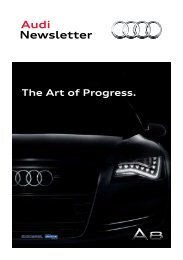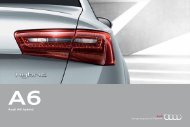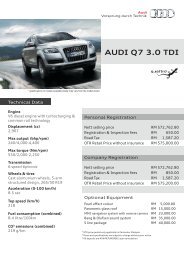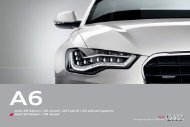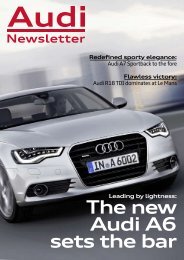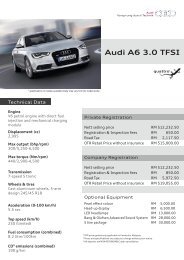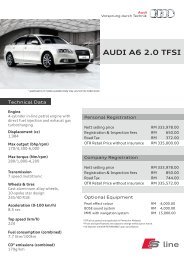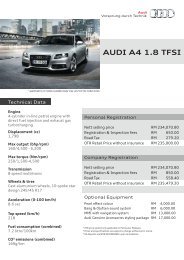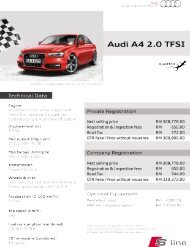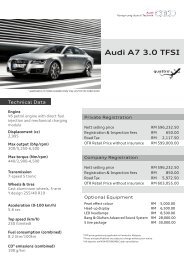drive - Audi
drive - Audi
drive - Audi
Create successful ePaper yourself
Turn your PDF publications into a flip-book with our unique Google optimized e-Paper software.
In the cozy dining room run by his friends Sonja andFranz Berlesreiter, the Head of <strong>Audi</strong> Motorsporttakes a rare opportunity to leave cars, speed and racing behind.column //Go with the flowMany car <strong>drive</strong>rs consider bike lanes simply lost space that’s been stolen from theirstreets. Tom Vanderbilt appeals to roads users with engines to show moreunderstanding for those with pedals. They might even learn a thing or two.We often treat cars and bicycles as an either-orfront meant I had to brake more often, more severely, andproposition. You’re a “cyclist” or a “<strong>drive</strong>r,” with a wholethen pedal that much more to keep pace. In traffic, engi-host of associations tied up in your choice, and to giveneers similarly talk of a “bullwhip effect,” in which the lastroad space to one mode is to take it away from the other.<strong>drive</strong>r in a line of closely spaced cars may not be able toSomewhere between the windshield and the wraparoundbrake in time because someone up the line took too longconcern myself with my job. I love taking long bike ridessunglasses, there’s a mile of room for misunderstanding.to brake, “consuming” the extra space. Of course, in trafficwith my wife, Antje, and our son, Timo, and you simplyBut most cyclists are also <strong>drive</strong>rs—even if the opposite iswe can’t always get to the front of the group, but the les-have to put your personal life first sometimes; after all,not as true—and, far from being an on-road menace forson here is: In heavy traffic, driving too close to the <strong>drive</strong>rI’m not a racing machine. And that’s also an attitude I trycars, bikes should claim their own space. In fact, researchin front can be not only counterproductive, but dangerous.to impress upon my <strong>drive</strong>rs: Sometimes you have to switchfrom New York and other large cities shows that streetsoff completely, so you can then come back and attack evenwith separated bike lanes added to them become safer forThis speaks to another lesson of cycling: learningharder.all road users, not just cyclists. There’s another benefithow to ride in a group. The peloton is, as one social sci-That includes quattro <strong>drive</strong>, TFSI technology andthe twelve-cylinder diesel engine in the <strong>Audi</strong> R10 we wonthe historic victory in the 24 Hours of Le Mans with in 2006.It was the first time a race car with a diesel engine hadever won, which nobody had ever considered possible. Thenearly unanimous assumption was, “That’ll never happen!”Now you and your team have taken on another extremelychallenging project ...That’s for sure. Five years ago we started workingon the first concepts to develop hybrid technology forLe Mans, and now we’re ready for the race. I’m confidentthat the <strong>Audi</strong> R18 e-tron quattro with all-wheel <strong>drive</strong> anda diesel hybrid engine will make a great showing. It’s thesame for the <strong>drive</strong>rs as for the engineers, you have to keepon coaxing their very best performance out of them. Weknow we’ve got the greatest passion and competence inour court. But every single season, we have to give it everythingwe’ve got and fight tooth and nail. The thing that’sboth merciless and beautiful about racing is that the feedbackis immediate: You either win or you lose, it’s as simpleas that.You’ve been racking up one victory after another for nearly20 years now. Do you feel the pressure that comes withsuccess?I try to channel it positively, and I pass that positiveenergy on to the team. In a nutshell, the trick we manageto pull off season after season is to distill pressure andmotivation into top performance.Do you ever have dreams before or after race weekends?I don’t actually dream much at all—and when I do,it’s definitely not about motorsport. On the rare days whenI’m at home in Oberstimm during the season, I hardly everThank you very much. //Dr. Wolfgang UllrichUllrich was born in Vienna, Austria, on August 27, 1950. Aftercompleting his schooling, he studied automotive engineeringthere with a view to a career in research and development in theautomotive industry. Over his nineteen-year tenure as Head ofSport and Special Developments at <strong>Audi</strong>, or Head of <strong>Audi</strong> Motorsportfor short, Wolfgang Ullrich has overseen some of the mostsuccessful projects in <strong>Audi</strong> Sport history: The <strong>Audi</strong> A4 Supertouring,the Le Mans sports cars, the <strong>Audi</strong> A4 DTM and the developmentof the diesel hybrid engine mentioned above. Dr. WolfgangUllrich has been in charge of developing and expanding the customerracing program at <strong>Audi</strong> since 2009. He lives with his wife,Antje, and his son, Timo, in Oberstimm, a village near Ingolstadt.The Head of <strong>Audi</strong> Motorsport is a cyclist, skier and hiker of remarkablestamina and enthusiasm.For more information on <strong>Audi</strong> motorsport,go to www.audi.com/motorsport.You can find the Berggasthof Biberg onlineat www.berggasthof-biberg.at.Trafficologyof cycling: It can make you a better <strong>drive</strong>r. I mean thisnot simply in the sense that you gain an empathy for andunderstanding of cyclists’ behavior; rather, cycling itselfcontains its own lessons that turn out to be curiously applicableto life behind the wheel.Consider the question of energy. Save for thosewho have real-time feedback devices telling them howmuch energy they are consuming, it’s easy for <strong>drive</strong>rs tolose sight of how to use energy efficiently. The ease of thegas pedal seduces us. We accelerate at the wrong timesand brake too often. Driven in this manner, a small car beginsto take on the fuel economy profile of a larger vehicle.On a bike, however, every ounce of horsepower comes fromthe cyclist (with an occasional assist from gravity). Theworst thing you can do is interrupt your own momentum—whether it’s choosing too big a gear as you begin to ascenda hill, hard-braking at a traffic light rather than slowingto coast through the green, or not pedaling consistentlyaround a corner.These dynamics are seen in the dynamics of thepeloton, or the main cluster of riders in a group ride. On arecent long road ride from Boston to New York City, I foundmyself, late one day, flagging near the back of the group,struggling to keep up. A professional racer rode alongsideand offered a bit of counterintuitive advice: If you’re feelingtired, he said, work your way up to the front of thegroup. But weren’t they going faster, I wondered? Wasn’tit better to drift in the slipstream?The reason was something I recognized from researchinto highway traffic behavior. Being at the endof that long line of cyclists, I was least attuned to whatthe pack was doing. Every time someone near the frontslowed, every succeeding cyclist slowed—each at a slightlydifferent rate—the result being that by the time the slowing“wave” reached me, I was, in essence, reacting to everyoneelse’s reaction time. So every little perturbation upExperience the audio version of the column inthe <strong>Audi</strong> magazine iPad App.entist described it, a “collective decision-making group,”a kind of living, breathing organism comprised of multipleactors working in unison for a common goal. Oneof the keys to successful behavior is communication, inpart because the consequences of mistakes on a bike canbe that much more dangerous. Cyclists in a group ride areconstantly pointing out hazards to those behind, so that adeep pothole sets off a successive wave of hand gesturesor shouts back down the line.In traffic, we are constantly participating in a sortof impromptu pelotons as we <strong>drive</strong> on the highway, but<strong>drive</strong>rs, sealed off from one another, often neglect to communicate.(The car has turn signals for a reason.) Anotherlesson here is that, in cycling, you don’t want to rely onlyon the rider ahead for information, for by then it may betoo late to act. Similarly, in driving, what’s happening twoor three cars ahead is often more important than what the<strong>drive</strong>r right in front of you is doing.Even something like steering, which one mightpresume to be radically different on a bike, can be appliedto driving. On a recent “Belgian style” race, featuring sectionsof loose gravel roads, I found myself skidding overthe unfamiliar terrain. A more seasoned rider observedmy technique and said, “Look where you want to go.” Itsounded a bit mystical, but as I tried it, I found I had bettercontrol of the bike. Although it is still something of a scientificmystery, we seem to change our direction slightlytoward the object of our gaze; driving simulator studieshave shown <strong>drive</strong>rs drifting ever so slightly toward stimulion the side of the road. And so aligning one’s eyes towardone’s goal seems to produce smoother steering.Two wheels or four, the mantra is the same: Gowith the flow. //Our columnist writes for various international publications and is authorof the New York Times best seller Traffic: Why We Drive the WayWe Do (and What It Says About Us), which has so far been translatedinto 18 languages.Photo: Takahiro Yamamoto/Getty Images055 / Inspire / <strong>Audi</strong> magazine <strong>Audi</strong> magazine / 056



